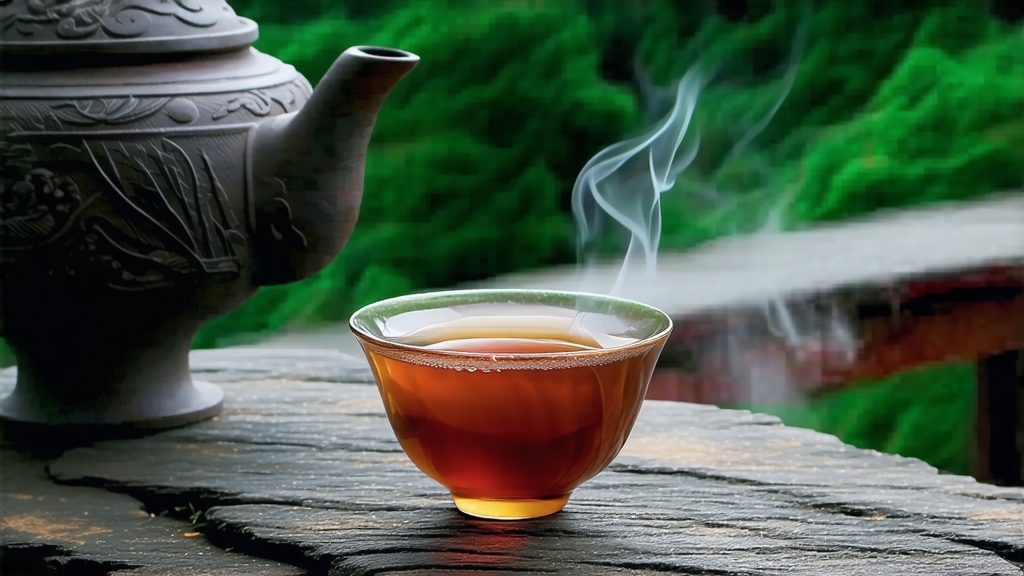
When Chinese tea lovers whisper the words “Da Hong Pao,” they are not simply naming a tea; they are invoking a legend carved into the vertical cliffs of northern Fujian’s Wuyi Mountains. Translated as “Big Red Robe,” this oolong is the most mythologized, counterfeited, and coveted leaf in China’s vast tea repertoire. To understand Da Hong Pao is to step into a world where geology, dynastic politics, monastic alchemy, and modern auction houses converge in a single cup.
Origin Myth and Imperial Robes
The name first appears in a Ming-dynasty anecdote. A Ming emperor’s mother fell gravely ill; monks from the Wuyi Tianxin Temple presented a tea plucked from six bushes growing in a narrow fissure so high above the Nine-Dragon Gorge that monkeys were trained to pick the leaves. The empress recovered, and the emperor, in gratitude, sent vermillion imperial robes to drape the bushes—hence “Big Red Robe.” Whether apocryphal or not, the tale cemented the tea’s status as tribute tea (gong cha) for centuries. In 2005, 20 grams of original-clone leaf from those mother bushes sold at auction for 208,000 RMB (roughly 25,000 USD), making Da Hong Pao the most expensive tea per gram on earth and turning the myth into headline news.
Terroir: The “Rock Rhyme”
Wuyi’s Danxia landform—purple-red sandstone and tuff compressed 100 million years ago—crumbles into mineral-rich soils that drain instantly on 70-degree slopes. The gorge traps morning fog, creating a humid microclimate that forces the tea bush to struggle, thickening cell walls and concentrating aromatic oils. Local tasters speak of yanyun—“rock rhyme”—a tactile after-impression that feels like licking a wet stone, followed by a cooling menthol lift in the throat. No other oolong is judged primarily by this mineral echo rather than floral fragrance.
Genealogy: Mother Trees, Cuttings, and Cultivars
The six original mother trees still cling to a cleft called Jiulong Ke, but since 2006 plucking from them has been banned to protect the 350-year-old plants. Today’s market offers three lineages:
- Beidou (Big Dipper) – direct cuttings from the mother trees, genetically identical, grown in the same cliff zone.
- Qidan (Scarlet Egg) – a separate Wuyi cultivar selected for its ability to mimic the mineral bite of the originals.
- Blended Yancha – skillful marriages of several Wuyi cultivars (Tie Luo Han, Bai Ji Guan, Shui Jin Gui) to recreate the original flavor spectrum.
Each expresses the “rock rhyme” differently: Beidou leans toward dark cacao and burnt sugar, Qidan toward lilac and wet slate, while blends can arc from peach skin to soy-milk sweetness.
Craft: The Charcoal Ballet
Da Hong Pao is the most labor-intensive Chinese tea, requiring 13 distinct steps across 24 hours. After picking, the leaves are withered on bamboo racks in direct sun for 20 minutes—just long enough for the edges to turn matte—then moved indoors for 2 hours of cool withering. The critical “yaoqing” (rocking-green) follows: 8–12 rounds of tossing the leaves in a rattan drum to bruise margins and trigger oxidation enzymes. Masters listen for a rustle like silk skirts, signaling the exact 30 % oxidation level that preserves green centers while rimming the leaf with copper.
Next comes the Wuyi signature: two separate roast cycles over glowing lychee-charcoal that burns at 80 °C for 8 hours, rest for 30 days, then a second 6-hour roast. The charcoal is quenched with wet ash to lower temperature by feel—no thermometers—because lycewood imparts a fruity smoke that flatters the mineral core. Over-roast and the tea tastes like burnt toast; under-roast and the fragrance remains grassy, lacking the deep cocoa finish that collectors prize.
Grading: Cliff, Semi-Cliff, and Garden
Government inspectors classify leaf by proximity to the core 60 km² scenic reserve:
- Zhengyan (True Cliff): plucked within the gorge itself, 600–800 m elevation, daily mist, yields roughly 500 kg per year.
- Banyan (Semi-Cliff